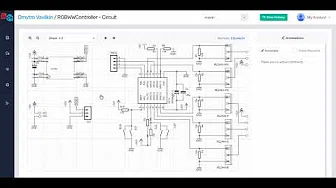Files
Last update 3 years 9 months
by eddyluursema
Sensor.cpp/********************************************************************** Sensor.cpp COPYRIGHT (c) 2013-2016 Gregg E. Berman Part of DCC++ BASE STATION for the Arduino **********************************************************************/ /********************************************************************** DCC++ BASE STATION supports Sensor inputs that can be connected to any Aruidno Pin not in use by this program. Sensors can be of any type (infrared, magentic, mechanical...). The only requirement is that when "activated" the Sensor must force the specified Arduino Pin LOW (i.e. to ground), and when not activated, this Pin should remain HIGH (e.g. 5V), or be allowed to float HIGH if use of the Arduino Pin's internal pull-up resistor is specified. To ensure proper voltage levels, some part of the Sensor circuitry MUST be tied back to the same ground as used by the Arduino. The Sensor code below utilizes exponential smoothing to "de-bounce" spikes generated by mechanical switches and transistors. This avoids the need to create smoothing circuitry for each sensor. You may need to change these parameters through trial and error for your specific sensors. To have this sketch monitor one or more Arduino pins for sensor triggers, first define/edit/delete sensor definitions using the following variation of the "S" command: <S ID PIN PULLUP>: creates a new sensor ID, with specified PIN and PULLUP if sensor ID already exists, it is updated with specificed PIN and PULLUP returns: <O> if successful and <X> if unsuccessful (e.g. out of memory) <S ID>: deletes definition of sensor ID returns: <O> if successful and <X> if unsuccessful (e.g. ID does not exist) <S>: lists all defined sensors returns: <Q ID PIN PULLUP> for each defined sensor or <X> if no sensors defined where ID: the numeric ID (0-32767) of the sensor PIN: the arduino pin number the sensor is connected to PULLUP: 1=use internal pull-up resistor for PIN, 0=don't use internal pull-up resistor for PIN Once all sensors have been properly defined, use the <E> command to store their definitions to EEPROM. If you later make edits/additions/deletions to the sensor definitions, you must invoke the <E> command if you want those new definitions updated in the EEPROM. You can also clear everything stored in the EEPROM by invoking the <e> command. All sensors defined as per above are repeatedly and sequentially checked within the main loop of this sketch. If a Sensor Pin is found to have transitioned from one state to another, one of the following serial messages are generated: <Q ID> - for transition of Sensor ID from HIGH state to LOW state (i.e. the sensor is triggered) <q ID> - for transition of Sensor ID from LOW state to HIGH state (i.e. the sensor is no longer triggered) Depending on whether the physical sensor is acting as an "event-trigger" or a "detection-sensor," you may decide to ignore the <q ID> return and only react to <Q ID> triggers. **********************************************************************/ #include "DCCpp_Uno.h" #include "Sensor.h" #include "EEStore.h" #include <EEPROM.h> #include "Comm.h" /////////////////////////////////////////////////////////////////////////////// void Sensor::check(){ Sensor *tt; for(tt=firstSensor;tt!=NULL;tt=tt->nextSensor){ tt->signal=tt->signal*(1.0-SENSOR_DECAY)+digitalRead(tt->data.pin)*SENSOR_DECAY; if(!tt->active && tt->signal<0.5){ tt->active=true; INTERFACE.print("<Q"); INTERFACE.print(tt->data.snum); INTERFACE.print(">"); } else if(tt->active && tt->signal>0.9){ tt->active=false; INTERFACE.print("<q"); INTERFACE.print(tt->data.snum); INTERFACE.print(">"); } } // loop over all sensors } // Sensor::check /////////////////////////////////////////////////////////////////////////////// Sensor *Sensor::create(int snum, int pin, int pullUp, int v){ Sensor *tt; if(firstSensor==NULL){ firstSensor=(Sensor *)calloc(1,sizeof(Sensor)); tt=firstSensor; } else if((tt=get(snum))==NULL){ tt=firstSensor; while(tt->nextSensor!=NULL) tt=tt->nextSensor; tt->nextSensor=(Sensor *)calloc(1,sizeof(Sensor)); tt=tt->nextSensor; } if(tt==NULL){ // problem allocating memory if(v==1) INTERFACE.print("<X>"); return(tt); } tt->data.snum=snum; tt->data.pin=pin; tt->data.pullUp=(pullUp==0?LOW:HIGH); tt->active=false; tt->signal=1; pinMode(pin,INPUT); // set mode to input digitalWrite(pin,pullUp); // don't use Arduino's internal pull-up resistors for external infrared sensors --- each sensor must have its own 1K external pull-up resistor if(v==1) INTERFACE.print("<O>"); return(tt); } /////////////////////////////////////////////////////////////////////////////// Sensor* Sensor::get(int n){ Sensor *tt; for(tt=firstSensor;tt!=NULL && tt->data.snum!=n;tt=tt->nextSensor); return(tt); } /////////////////////////////////////////////////////////////////////////////// void Sensor::remove(int n){ Sensor *tt,*pp; for(tt=firstSensor;tt!=NULL && tt->data.snum!=n;pp=tt,tt=tt->nextSensor); if(tt==NULL){ INTERFACE.print("<X>"); return; } if(tt==firstSensor) firstSensor=tt->nextSensor; else pp->nextSensor=tt->nextSensor; free(tt); INTERFACE.print("<O>"); } /////////////////////////////////////////////////////////////////////////////// void Sensor::show(){ Sensor *tt; if(firstSensor==NULL){ INTERFACE.print("<X>"); return; } for(tt=firstSensor;tt!=NULL;tt=tt->nextSensor){ INTERFACE.print("<Q"); INTERFACE.print(tt->data.snum); INTERFACE.print(" "); INTERFACE.print(tt->data.pin); INTERFACE.print(" "); INTERFACE.print(tt->data.pullUp); INTERFACE.print(">"); } } /////////////////////////////////////////////////////////////////////////////// void Sensor::status(){ Sensor *tt; if(firstSensor==NULL){ INTERFACE.print("<X>"); return; } for(tt=firstSensor;tt!=NULL;tt=tt->nextSensor){ INTERFACE.print(tt->active?"<Q":"<q"); INTERFACE.print(tt->data.snum); INTERFACE.print(">"); } } /////////////////////////////////////////////////////////////////////////////// void Sensor::parse(char *c){ int n,s,m; Sensor *t; switch(sscanf(c,"%d %d %d",&n,&s,&m)){ case 3: // argument is string with id number of sensor followed by a pin number and pullUp indicator (0=LOW/1=HIGH) create(n,s,m,1); break; case 1: // argument is a string with id number only remove(n); break; case -1: // no arguments show(); break; case 2: // invalid number of arguments INTERFACE.print("<X>"); break; } } /////////////////////////////////////////////////////////////////////////////// void Sensor::load(){ struct SensorData data; Sensor *tt; for(int i=0;i<EEStore::eeStore->data.nSensors;i++){ EEPROM.get(EEStore::pointer(),data); tt=create(data.snum,data.pin,data.pullUp); EEStore::advance(sizeof(tt->data)); } } /////////////////////////////////////////////////////////////////////////////// void Sensor::store(){ Sensor *tt; tt=firstSensor; EEStore::eeStore->data.nSensors=0; while(tt!=NULL){ EEPROM.put(EEStore::pointer(),tt->data); EEStore::advance(sizeof(tt->data)); tt=tt->nextSensor; EEStore::eeStore->data.nSensors++; } } /////////////////////////////////////////////////////////////////////////////// Sensor *Sensor::firstSensor=NULL;








